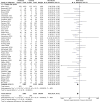Probiotics for the prevention of antibiotic-associated diarrhoea: a systematic review and meta-analysis
- PMID: 34385227
- PMCID: PMC8362734
- DOI: 10.1136/bmjopen-2020-043054
Probiotics for the prevention of antibiotic-associated diarrhoea: a systematic review and meta-analysis
Abstract
Objective: To evaluate existing evidence for the use of probiotics in preventing antibiotic-associated diarrhoea (AAD) in adults.
Design: Systematic review and meta-analysis of randomised controlled trials (RCTs).
Data sources: We performed a literature search of the electronic databases CINAHL Plus, EMBASE, MEDLINE (Ovid) and Web of Science from database inception to May 2021 as well as hand searching of trial registries and reference lists of related reviews.
Study selection: Two reviewers identified whether RCTs met the following inclusion criteria: adult population to whom antibiotics were administered; a probiotic intervention; a placebo, alternative dose, alternative probiotic strain or no treatment control; and incidence of AAD as the outcome.
Data extraction and synthesis: Two reviewers independently collected data and assessed risk of bias using preconstructed data extraction forms. We used a random effects model for all analyses. Subgroup analyses were performed to evaluate species-specific and dose-specific response.
Results: Forty-two studies (11,305 participants) were included in this review. The pooled analysis suggests that co-administration of probiotics with antibiotics reduces the risk of AAD in adults by 37% (risk ratio (RR)=0.63 (95% CI 0.54 to 0.73), p<0.00001). The overall quality of the evidence using the Grading of Recommendations, Assessment, Development and Evaluations (GRADE) criteria was found to be moderate. In subgroup analyses, high dose compared with low dose of the same probiotic demonstrated a positive protective effect (RR 0.54 (95% CI 0.38 to 0.76), p<0.01), and only certain species, mainly of the lactobacillus and bifidobacteria genera, were found to be effective. Studies with a low baseline AAD risk did not show any difference in risk but studies with moderate or high baseline AAD risk demonstrated a significant risk reduction.
Conclusions: Probiotics are effective for preventing AAD. Secondary analyses of higher dosages and certain species have shown increased effectiveness. Our results may not be applicable in clinical scenarios of lower baseline AAD risk.
Keywords: adult gastroenterology; bacteriology; gastroenterology; gastrointestinal infections; nutrition & dietetics; preventive medicine.
© Author(s) (or their employer(s)) 2021. Re-use permitted under CC BY-NC. No commercial re-use. See rights and permissions. Published by BMJ.
Conflict of interest statement
Competing interests: None declared.
Figures




References
Publication types
MeSH terms
Substances
LinkOut - more resources
Full Text Sources
Miscellaneous
